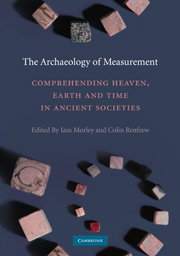Book contents
- Frontmatter
- Contents
- List of figures and tables
- List of contributors
- Acknowledgements
- The Archaeology of Measurement
- Introduction: Measure: Towards the construction of our world
- SECTION I NUMBER: COUNTING, MATHEMATICS AND MEASURE
- SECTION II MATERIALISING THE ECONOMY
- SECTION III DIMENSIONS AND BELIEF
- SECTION IV CALENDAR AND COSMOLOGY
- SECTION V THE SPIRITUALITY OF MEASURE
- Index
SECTION II - MATERIALISING THE ECONOMY
Published online by Cambridge University Press: 05 June 2012
- Frontmatter
- Contents
- List of figures and tables
- List of contributors
- Acknowledgements
- The Archaeology of Measurement
- Introduction: Measure: Towards the construction of our world
- SECTION I NUMBER: COUNTING, MATHEMATICS AND MEASURE
- SECTION II MATERIALISING THE ECONOMY
- SECTION III DIMENSIONS AND BELIEF
- SECTION IV CALENDAR AND COSMOLOGY
- SECTION V THE SPIRITUALITY OF MEASURE
- Index
Summary
The second section of the book deals specifically with the archaeological identification of the application of measurement to systems of economy and trade. Anna Michailidou opens her consideration of weighing in the Bronze Age Aegean by giving an overview of the occurrence of relative and absolute measurement in Egypt and ancient Greece, where – with an explicit connection between measurement and religion – the invention of systematic weighing was credited to the god Thoth and the hero Palamedes (great-great-great-grandson of Poseidon), respectively. Weighing is attested archaeologically by balances and numerous balance weights, as well as in written sources. The weighing system and activities of the Aegean have to be understood in the context of the other weighing systems and trade activities of the time. Some weights in use in the Aegean and Near East seem to have been deliberately manufactured to act as ‘nodal points’ for other weighing systems of the period. For example, the Aegean unit of ca. 65.5 grams could have represented 5 Egyptian deben, 8 Egyptian shaty, and 10 Near Eastern shekel.
It seems that many foodstuffs (e.g., grain, flour, pulses, oil, wine) were measured by volume rather than weight (excepting bread, fish, and meat), but that commodities such as metals, yarns, textiles, some wood and ivory, and condiments, dyes, and spices were measured by weight.
- Type
- Chapter
- Information
- The Archaeology of MeasurementComprehending Heaven, Earth and Time in Ancient Societies, pp. 69 - 70Publisher: Cambridge University PressPrint publication year: 2010



